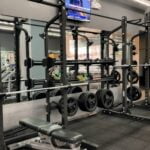Tennis is a sport that demands a combination of skill, agility, strength, and endurance. To excel on the court, players must not only master their strokes and strategy but also prioritize their physical fitness. In this article, we will explore the best fitness exercises for tennis players to enhance their performance and prevent injuries. From dynamic warm-up routines to core strengthening exercises, we will cover all aspects of fitness essential for success in tennis.
Being physically fit is more than just a bonus for tennis players – it is a necessity. The intense rallies and quick movements on the court require athletes to have excellent cardiovascular endurance, agility, speed, strength, and flexibility. Without proper conditioning, players may find themselves fatigued quickly or susceptible to injuries that could hinder their game. By incorporating the right fitness exercises into their training regimen, tennis players can improve their overall performance and longevity in the sport.
Throughout this article, we will delve into different types of exercises tailored specifically for tennis players. Whether you are looking to boost your speed in reaching shots across the court or strengthen your core for powerful serves and groundstrokes, these workouts will help you elevate your game to the next level.
Stay tuned as we guide you through dynamic warm-up routines, cardiovascular exercises, strength training drills, agility and speed workouts, core strengthening exercises, flexibility routines, as well as cool down and recovery techniques designed to keep you at the top of your game on the court.
Dynamic Warm-Up Exercises
When it comes to tennis, proper warm-up exercises are crucial to prepare the body for the physical demands of the game. Dynamic warm-up routines help increase blood flow to the muscles, improve flexibility, and reduce the risk of injuries during intense play. One of the best fitness exercises for tennis players is high knees.
This exercise involves running in place while bringing your knees up towards your chest with each step. High knees not only elevate your heart rate but also engage your core and lower body muscles, making it an ideal warm-up routine before hitting the court.
Another beneficial dynamic warm-up exercise is leg swings. Leg swings target the hamstrings and hip flexors while promoting hip mobility, which is essential for quick lateral movements in tennis. Begin by holding onto a stable surface for support and swing one leg forward and backward in a controlled motion.
Switch sides after a few repetitions to ensure both legs are adequately warmed up. Including leg swings in your warm-up routine can enhance your range of motion and prevent muscle strains during gameplay, making it a valuable addition to any tennis player’s pre-match preparation.
Incorporating lateral lunges into your dynamic warm-up can also significantly benefit tennis players. Lateral lunges work on strengthening the inner and outer thighs, as well as improving hip flexibility – all important components for agile movement on the tennis court. To perform lateral lunges correctly, start by standing tall with feet shoulder-width apart, then step out to the side with one leg while keeping the other leg straight.
Bend the knee of the extended leg while keeping your torso upright, then return to starting position and switch sides. By integrating lateral lunges into your warm-up routine, you can better equip your body for dynamic movements required in a fast-paced game of tennis.
| Exercise | Description |
|---|---|
| High Knees | Running in place while bringing knees up towards chest; engages core and lower body muscles |
| Leg Swings | Swinging legs forward and backward to target hamstrings and hip flexors; improves hip mobility |
| Lateral Lunges | Stepping out to side with one leg while bending knee; strengthens inner & outer thighs for agile movement |
Cardiovascular Exercises
Cardiovascular endurance is crucial for tennis players as it directly impacts their ability to maintain high-intensity rallies and perform at an optimal level throughout a match. Incorporating specific cardiovascular exercises into your training routine can help improve stamina, speed up recovery between points, and enhance overall on-court performance. Here are some of the best cardiovascular exercises for tennis players:
- Running or Jogging: Long-distance running or jogging is a fantastic way to build aerobic endurance, which is essential for sustained performance during a tennis match. Consider incorporating interval training, where you alternate between periods of high-intensity sprints and active recovery jogs, to simulate the stop-and-go nature of tennis.
- Jump Rope: Jumping rope is a highly effective cardiovascular workout that also helps improve footwork and agility – critical components in tennis. Try different variations such as double-unders, single-leg jumps, or side-to-side jumps to keep the exercise challenging and engaging.
- Cycling: Whether on a stationary bike or outdoors, cycling is an excellent low-impact cardio exercise that effectively targets the lower body muscles while improving cardiovascular fitness. Mix up your cycling routine by incorporating hill climbs or interval sprints to mimic the intensity of tennis gameplay.
Incorporating these cardiovascular exercises into your training regimen will not only boost your endurance on the court but also contribute to your overall fitness level as a tennis player. Remember to combine these workouts with proper hydration, nutrition, and rest to maximize your performance and prevent fatigue during matches. By prioritizing cardiovascular training alongside other fitness aspects specific to tennis, you’ll be well-equipped to handle the physical demands of the sport and elevate your game to new heights.
Strength Training Exercises
When it comes to being a successful tennis player, strength is a crucial component that should not be overlooked. Strength training exercises play a vital role in improving power, stability, and injury prevention on the court. By incorporating specific exercises into their fitness routine, tennis players can enhance their performance and stay competitive during matches.
Importance of Strength Training for Tennis Players
Strength training is essential for tennis players as it helps improve muscle endurance, which is necessary for long matches that require repeated explosive movements. Building strength also contributes to overall body stability, reducing the risk of injuries during dynamic movements like sudden stops and quick direction changes. Additionally, a strong musculature can help generate more power behind shots like serves and groundstrokes, giving players an edge over their opponents.
Best Strength Training Exercises for Tennis Players
Some of the best strength training exercises for tennis players include squats, lunges, deadlifts, and rows. These compound movements target multiple muscle groups simultaneously, mimicking the demands of a tennis match.
Incorporating exercises that focus on both upper body and lower body strength can help maintain balance in muscle development and prevent any muscular imbalances that may impact performance or lead to injuries. Using resistance bands or free weights can add an extra challenge and variety to strength training routines tailored for tennis players.
Agility and Speed Drills
Agility and speed are crucial components of a successful tennis game. The ability to swiftly move around the court, change directions quickly, and reach for difficult shots can make all the difference between winning and losing a point. Incorporating specific agility and speed drills into your training regimen can help improve these aspects of your game. Here are some of the best drills to enhance quick movements on the court:
- Ladder Drills: Agility ladder drills are excellent for improving footwork, coordination, and overall agility. Set up an agility ladder on the court or any flat surface, and perform exercises such as high knees, lateral shuffles, or quick feet drills through the rungs.
- Cone Drills: Set up cones in various patterns on the court and practice moving in different directions quickly around them. This will help you improve your change of direction abilities and reaction time during a match.
- Suicide Runs: Suicide runs involve sprinting to specified points on the court (or markers set up) at increasing speeds before reversing back to start again. This drill is excellent for building speed and endurance simultaneously.
These agility and speed drills not only enhance your physical capabilities but also work on your mental sharpness during a match. The more you practice these exercises regularly, the more agile and quick you will become on the tennis court. Remember that incorporating these drills along with other best fitness exercises for tennis will give you a well-rounded training routine that can significantly improve your performance on the court.
Core Strengthening Exercises
A strong core is essential for tennis players as it forms the foundation for all their movements on the court. A strong core not only helps in generating power for shots but also provides stability and balance during quick changes in direction. Incorporating specific core strengthening exercises into a tennis player’s fitness routine can greatly improve their performance and reduce the risk of injury.
Importance of Core Strength for Tennis Players
Tennis involves a significant amount of rotation, lateral movement, and explosive power which heavily relies on a strong core. A well-developed core enhances a player’s ability to generate power in their shots, maintain a stable posture during movements, and transfer energy efficiently from the lower body to the upper body.
It also plays a crucial role in preventing injuries, especially in the lower back region, which is common among tennis players due to the repetitive twisting and turning motions involved in the game.
Best Core Strengthening Exercises for Tennis
One of the best fitness exercises for tennis players to strengthen their core is the plank exercise. Planks target multiple muscle groups in the core including the rectus abdominis, obliques, and transverse abdominis. Other effective exercises include Russian twists, bicycle crunches, and leg raises.
These exercises not only build strength but also improve endurance in the core muscles which is essential for maintaining performance throughout a match. Including these exercises consistently in a tennis player’s workout routine can lead to better stability, balance, and overall performance on the court.
Flexibility Exercises
Flexibility is a crucial component of fitness for tennis players as it plays a significant role in enhancing performance and reducing the risk of injuries on the court. By incorporating flexibility exercises into your training routine, you can improve your range of motion, agility, and overall movement quality during matches.
Stretching regularly helps to lengthen muscles, improve joint mobility, and maintain muscle balance essential for preventing strains or sprains during intense gameplay. Therefore, dedicating time to focus on flexibility exercises can significantly benefit your tennis game.
One of the best ways to promote flexibility for tennis players is through dynamic stretching routines that mimic the movements required during a match. Dynamic stretches not only help to improve flexibility but also warm up the muscles and prepare them for physical activity. These stretches involve continuous motion that gradually increases the range of motion in specific muscle groups without holding any position for too long.
Examples of dynamic stretching exercises include leg swings, arm circles, and torso twists, which target key areas used in tennis movements. Incorporating dynamic stretches into your warm-up routine can help optimize your performance on the court while reducing the risk of injuries.
In addition to dynamic stretching, static stretches are also beneficial for improving flexibility in tennis players. Static stretches involve holding a position for a prolonged period to elongate the muscles and improve overall flexibility. Targeting major muscle groups such as hamstrings, quadriceps, calves, shoulders, and back with static stretching can help increase joint mobility essential for executing powerful serves, forehands, backhands, and other dynamic movements in tennis.
Implementing a combination of dynamic and static stretching exercises into your regular training regimen can enhance your overall flexibility, reduce muscle tension, and contribute to better performance on the court. By prioritizing flexibility exercises tailored for tennis players, you can elevate your game by promoting efficient movement patterns and preventing potential injuries associated with insufficient flexibility levels.
Cool Down and Recovery Techniques
Cooling down and allowing for proper recovery after intense tennis workouts are crucial aspects of any athlete’s training routine. A well-planned cool-down can help prevent injuries, reduce muscle soreness, and promote overall recovery. One effective cool-down technique is to perform light cardiovascular exercises like jogging or walking to gradually lower your heart rate and relax your muscles. Additionally, incorporating dynamic stretches focusing on the muscles used during tennis can aid in maintaining flexibility and preventing tightness.
Proper nutrition plays a vital role in recovery after tennis workouts. Consuming a balanced post-workout meal containing carbohydrates, protein, and healthy fats within 30 minutes of exercise can facilitate muscle repair and replenish glycogen stores. Hydration is also key to aiding recovery, as staying properly hydrated helps flush out toxins from the body and supports overall performance. Adding electrolytes to your water or consuming sports drinks can be beneficial, especially after prolonged or intense training sessions.
Incorporating foam rolling or using massage tools like lacrosse balls can target specific areas of tightness or trigger points post-workout, promoting better blood circulation and relieving muscle tension. Active recovery techniques such as gentle yoga or swimming can also aid in reducing muscle soreness while promoting flexibility. Remember that adequate rest and sleep are equally important for recovery, as they allow your body to repair and rebuild following intense physical exertion.
| Cool Down Strategies | Recovery Techniques |
|---|---|
| Perform light cardiovascular exercises | Consume balanced post-workout meals |
| Incorporate dynamic stretches | Stay properly hydrated |
| Utilize foam rolling or massage tools | Practice active recovery techniques |
Conclusion
In conclusion, maintaining a high level of fitness is crucial for tennis players to perform at their best on the court. The best fitness exercises for tennis encompass various aspects including dynamic warm-up exercises, cardiovascular workouts, strength training routines, agility drills, core strengthening exercises, flexibility routines, as well as cool down and recovery techniques. By incorporating these exercises into their training routine, tennis players can improve their endurance, power, speed, agility, and overall performance on the court.
It is important for players to understand that a well-rounded fitness regimen not only enhances their physical abilities but also reduces the risk of injuries. Dynamic warm-up exercises prepare the body for the demands of tennis by increasing blood flow and activating muscles. Cardiovascular exercises improve endurance necessary for long matches and intense rallies.
Strength training exercises build muscle strength required for powerful strokes and quick movements. Agility drills enhance reaction time and footwork essential for swift changes in direction on the court.
By committing to a comprehensive fitness program that includes all these components, tennis players can elevate their game to new levels. Whether you are a beginner or a seasoned player, focusing on these best fitness exercises for tennis will undoubtedly help you achieve your full potential on the court.
So let’s lace up our sneakers, grab our rackets, and hit the courts with confidence knowing that we have put in the hard work off-court to excel in every match we play.
Frequently Asked Questions
How Can I Improve My Fitness for Tennis?
Improving fitness for tennis involves a combination of cardiovascular endurance, strength training, flexibility, and agility exercises. Cardio helps with endurance on the court, while strength training builds muscles needed for powerful shots. Incorporating agility drills can improve footwork and reaction time.
What Exercises Increase Stamina for Tennis?
Exercises that increase stamina for tennis focus on building endurance through activities like running, cycling, or swimming. Interval training can also be beneficial for improving cardiovascular fitness and stamina on the court. Engaging in prolonged rallies during practice matches can help simulate match conditions and enhance stamina.
How Do You Build a Tennis Body?
Building a tennis body requires a combination of strength training to develop core stability, upper body strength for powerful shots, and lower body strength for swift movement across the court. Additionally, incorporating flexibility exercises can improve range of motion for hitting shots from various positions.
Proper nutrition and hydration are essential to support muscle growth and recovery in building a strong tennis body.

Passionate about providing useful information to anyone with an interest in the field of Personal Training, I strive to pass on to our readers quality information and to answer any questions about Personal Trainers, the work they do and how to become one.





